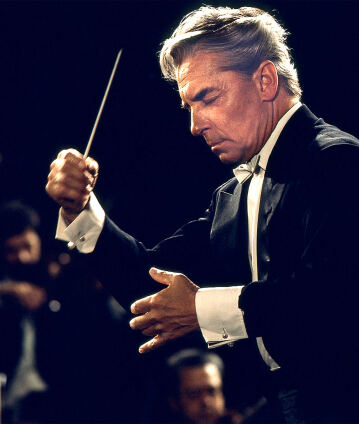Karajan conducts Beethoven’s Symphonies Nos. 3 & 7

With his Third Symphony, the Eroica, Ludwig van Beethoven presents himself for the first time as a Titan who fearlessly faces his fate. Herbert von Karajan and the Berliner Philharmoniker are equally gripping in their interpretation, which was documented by director Hugo Niebeling with an intriguing visual concept. Beethoven’s Seventh is presented here in the same format.
Herbert von Karajan first conducted Beethoven in public in Ulm in 1931. The work was the Eroica Symphony, an ambitious undertaking for a 23-year-old assistant Kapellmeister directing a provincial opera orchestra. “One listened and was astonished,” reported the local newspaper.
As a young man Karajan worked assiduously to reconcile the old Wagner-derived German Romantic school of Beethoven interpretation with the quicker and texturally more transparent style of Beethoven interpretation which was being pioneered by conductors such as Arturo Toscanini and Richard Strauss. It was a daunting task. Speaking of the Bacchanalian Seventh Symphony, Karajan recalled: “When I was a young conductor in Germany, it was usual to conduct the finale much slower than we hear nowadays. I knew this was wrong but I couldn’t escape this tradition because of the difficulty of realising the inner content of the music.”
Part of Karajan’s inheritance when he became artistic director of the Berliner Philharmoniker was the visceral intensity of the orchestra’s playing. This became an important element in the now legendary Beethoven performances which he and the Berliner Philharmoniker gave on record and in concert halls in Europe, Japan and the United States during the 1960s and 1970s. In London in 1961 a critic wrote: “The playing throughout the evening was truly superb, every instrumentalist bowing and blowing and thumping as though for dear life. The violins waved and swayed like cornstalks in the wind. Every note had vitality, yet every note was joined to all the others. There were no tonal lacunae, not a hiatus all night. We could hear things which usually we are obliged to seek out by eyes reading the score.”
It is that experience which avant-garde film-maker Hugo Niebeling (b. 1930) preserved for all time in these brilliantly conceived 1971 films of the Third and Seventh Symphonies. In both films, the orchestra is placed in three steeply rising triangles, echoing the shape of the ancient Greek theatre, whose rows of seats rose up the slope from a round orchestra – the area where the choir performed in antiquity. As baleful discords blaze out at the climax of the Eroica Symphony’s first movement development, the camera cuts to the bells of the trumpets lit from behind by a fierce blaze of light.
© 1972 Unitel
Artistes
Nos suggestions
- Karajan conducts Brahms’s “German Requiem” in Salzburg
- Karajan and Weissenberg perform Tchaikovsky and Rachmaninov
- Karajan conducts the 1978 New Year’s Eve Concert
- Karajan conducts Tchaikovsky’s Symphonies Nos. 4–6
- Karajan conducts Beethoven’s Symphony No. 5
- Karajan conducts Beethoven’s Symphonies Nos. 1 & 4